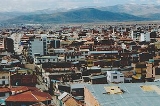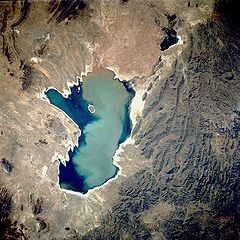
Oruro, Bolivia
Encyclopedia
Oruro is a city in Bolivia
with a population of 235,393 (2010 calculation), located about equidistant between La Paz and Sucre
at approximately 3710 meters above sea level. It is the capital of the department of Oruro
.
The city was first founded on November 1, 1606 by Don Manuel Castro de Padilla. as a silver
mining center in the Urus
region. At the time, it was named Real Villa de San Felipe de Austria after the Spanish
monarch, Philip III
. It was eventually abandoned as the silver mines became exhausted. Oruro was reestablished in the late nineteenth century, as a tin
mining center. For a time, the La Salvadora tin mine was the most important source of tin in the world. Gradually, this resource was also exhausted, and Oruro again went into a decline. The city does manage, however, to attract tourists to its carnival, the Carnaval de Oruro
, considered one of the great folkloric events in South America
for its masked " diablada".
.jpg)
.jpg) Oruro was named after the native tribe "Uru-Uru".
Oruro was named after the native tribe "Uru-Uru".
The city is the seat of the Roman Catholic Diocese of Oruro
. The Oruro Symphony Orchestra
is based in Oruro. Aymara painter and printmaker Alejandro Mario Yllanes
(1913–1960) was born here.
 The city of Oruro lies north of the salty lakes Uru-Uru and Poopó and it is just three hours (by bus) south from La Paz. Located at an altitude of 3709 meters above sea level, Oruro its well known for its cold weather. Warmer temperatures generally take place during August, September and October, after the worst of the winter chills and before the summer rains. From May to early July, night time temperatures combined with cool wind can bring the temperature down to about -20 °C. Summers are warmer, but despite the fact of being an arid area, there's quite a lot of rainfall between November and March.
The city of Oruro lies north of the salty lakes Uru-Uru and Poopó and it is just three hours (by bus) south from La Paz. Located at an altitude of 3709 meters above sea level, Oruro its well known for its cold weather. Warmer temperatures generally take place during August, September and October, after the worst of the winter chills and before the summer rains. From May to early July, night time temperatures combined with cool wind can bring the temperature down to about -20 °C. Summers are warmer, but despite the fact of being an arid area, there's quite a lot of rainfall between November and March.
Bolivia
Bolivia officially known as Plurinational State of Bolivia , is a landlocked country in central South America. It is the poorest country in South America...
with a population of 235,393 (2010 calculation), located about equidistant between La Paz and Sucre
Sucre
Sucre, also known historically as Charcas, La Plata and Chuquisaca is the constitutional capital of Bolivia and the capital of the department of Chuquisaca. Located in the south-central part of the country, Sucre lies at an elevation of 2750m...
at approximately 3710 meters above sea level. It is the capital of the department of Oruro
Oruro Department
Oruro is a department in Bolivia, with an area of 53,588 km². Its capital is the city of Oruro. At the time of census 2001 it had a population of 391,870.- Provinces of Oruro :...
.
The city was first founded on November 1, 1606 by Don Manuel Castro de Padilla. as a silver
Silver
Silver is a metallic chemical element with the chemical symbol Ag and atomic number 47. A soft, white, lustrous transition metal, it has the highest electrical conductivity of any element and the highest thermal conductivity of any metal...
mining center in the Urus
Uros
The Uros are a pre-Incan people who live on forty-two self-fashioned floating islands in Lake Titicaca Puno, Peru and Bolivia. They form three main groups: Uru-Chipayas, Uru-Muratos and the Uru-Iruitos...
region. At the time, it was named Real Villa de San Felipe de Austria after the Spanish
Spain
Spain , officially the Kingdom of Spain languages]] under the European Charter for Regional or Minority Languages. In each of these, Spain's official name is as follows:;;;;;;), is a country and member state of the European Union located in southwestern Europe on the Iberian Peninsula...
monarch, Philip III
Philip III of Spain
Philip III , also known as Philip the Pious, was the King of Spain and King of Portugal and the Algarves, where he ruled as Philip II , from 1598 until his death...
. It was eventually abandoned as the silver mines became exhausted. Oruro was reestablished in the late nineteenth century, as a tin
Tin
Tin is a chemical element with the symbol Sn and atomic number 50. It is a main group metal in group 14 of the periodic table. Tin shows chemical similarity to both neighboring group 14 elements, germanium and lead and has two possible oxidation states, +2 and the slightly more stable +4...
mining center. For a time, the La Salvadora tin mine was the most important source of tin in the world. Gradually, this resource was also exhausted, and Oruro again went into a decline. The city does manage, however, to attract tourists to its carnival, the Carnaval de Oruro
Carnaval de Oruro
The Carnival of Oruro is a more than 2000 year old religious celebration that, through creativity, continuity, and ritual, came to constitute a model of "Masterpieces of Oral Heritage and Intangible Heritage of Humanity...
, considered one of the great folkloric events in South America
South America
South America is a continent situated in the Western Hemisphere, mostly in the Southern Hemisphere, with a relatively small portion in the Northern Hemisphere. The continent is also considered a subcontinent of the Americas. It is bordered on the west by the Pacific Ocean and on the north and east...
for its masked " diablada".
.jpg)
.jpg)
The city is the seat of the Roman Catholic Diocese of Oruro
Roman Catholic Diocese of Oruro
The Roman Catholic Diocese of Oruro is a diocese located in the city of Oruro in the Ecclesiastical province of Cochabamba in Bolivia.-History:* November 11, 1924: Established as Diocese of Oruro from the Metropolitan Archdiocese of La Plata-Leadership:...
. The Oruro Symphony Orchestra
Oruro Symphony Orchestra
The Oruro Symphony Orchestra is a symphony orchestra based in Oruro, Bolivia. Under the directorship of Jesús Elías , they perform at the Teatro de la Casa Municipal de Cultura in Oruro.-Background and history:...
is based in Oruro. Aymara painter and printmaker Alejandro Mario Yllanes
Alejandro Mario Yllanes
Alejandro Mario Yllanes was an Aymara painter and printmaker from Bolivia. He disappeared from the public spotlight in 1946, after he was awarded, but did not claim, the Guggenheim Fellowship.-Art career:...
(1913–1960) was born here.
Climate

Main attractions
- Museo Patiño, former residence of "tin baron" Simón Iturri PatiñoSimón Iturri PatiñoDon Simón Iturri Patiño was a Bolivian industrialist who was among the world's wealthiest men at the time of his death. With a fortune built from ownership of a majority of the tin industry in Bolivia, Patiño was nicknamed "The Andean Rockefeller"...
- Museo Mineralógico (Mineralogical Museum): has exhibits of precious stones, minerals, and fossils
- Museo Etnográfico Minero (Ethnographical Mining Museum): housed in a mine tunnel, depicts methods of Bolivian mining
- Museo Nacional Antropológico Eduardo López Rivas(National Anthropological Museum): displays tools and information on the Chipayas and Urus tribes and Carnaval de OruroCarnaval de OruroThe Carnival of Oruro is a more than 2000 year old religious celebration that, through creativity, continuity, and ritual, came to constitute a model of "Masterpieces of Oral Heritage and Intangible Heritage of Humanity...
. - Churches: Catedral Nuestra Señora de la Asunción, Santuario de la Virgen del Socavón, Iglesia de Cunchupata
- Inti Raymi, a mine

